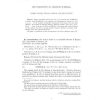Free Online Productivity Tools
i2Speak
i2Symbol
i2OCR
iTex2Img
iWeb2Print
iWeb2Shot
i2Type
iPdf2Split
iPdf2Merge
i2Bopomofo
i2Arabic
i2Style
i2Image
i2PDF
iLatex2Rtf
Sci2ools
ECCC
2008
2008
The complexity of learning SUBSEQ(A)
Higman essentially showed that if A is any language then SUBSEQ(A) is regular, where SUBSEQ(A) is the language of all subsequences of strings in A. Let s1, s2, s3, . . . be the standard lexicographic enumeration of all strings over some finite alphabet. We consider the following inductive inference problem: given A(s1), A(s2), A(s3), . . . , learn, in the limit, a DFA for SUBSEQ(A). We consider this model of learning and the variants of it that are usually studied in Inductive Inference: anomalies, mindchanges, teams, and combinations thereof. This paper is a significant revision and expansion of an earlier conference version [10].
Related Content
| Added | 10 Dec 2010 |
| Updated | 10 Dec 2010 |
| Type | Journal |
| Year | 2008 |
| Where | ECCC |
| Authors | Stephen A. Fenner, William I. Gasarch, Brian Postow |
Comments (0)

